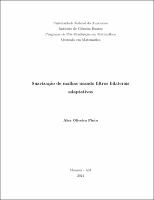| ???jsp.display-item.social.title??? |


|
Please use this identifier to cite or link to this item:
https://tede.ufam.edu.br/handle/tede/10748Full metadata record
| DC Field | Value | Language |
|---|---|---|
| dc.creator | Pinto, Alex Oliveira | - |
| dc.creator.Lattes | https://lattes.cnpq.br/7095624420456925 | eng |
| dc.contributor.advisor1 | Morera, Dimas Martinez | - |
| dc.contributor.advisor1Lattes | http://lattes.cnpq.br/9474423287192932 | eng |
| dc.contributor.referee2 | Cavalcante, Cicero Augusto Mota | - |
| dc.contributor.referee2Lattes | http://lattes.cnpq.br/9293110828710584 | eng |
| dc.contributor.referee3 | Vieira, Thales Miranda de Almeida | - |
| dc.contributor.referee3Lattes | http://lattes.cnpq.br/8181104476035846 | eng |
| dc.date.issued | 2024-06-18 | - |
| dc.identifier.citation | PINTO, Alex Oliveira. Suavização de malhas usando filtros bilaterais adaptativos. 2024. 59 f. Dissertação (Mestrado em Matemática) - Universidade Federal do Amazonas, Manaus (AM), 2024. | eng |
| dc.identifier.uri | https://tede.ufam.edu.br/handle/tede/10748 | - |
| dc.description.resumo | Em 1998, Tomasi e Manduchi introduziram o filtro bilateral para imagens cinzas e coloridas. Ele foi posteriormente estendido para realizar suavização de malhas com preservação de características por Fleishman et al. e Jones et al. Nesta dissertação, apresentamos um algoritmo de suavização de malhas usando filtros bilaterais adaptativos, que utiliza a arquitetura comum de Suavização de malhas em duas etapas. Na primeira etapa, aplicamos o filtro bilateral ao campo normal da malha considerando distâncias geodésicas entre centróides de faces adjacentes. Essa estratégia respeita a estrutura espacial da própria malha por meio do uso de métricas intrínsecas. Os parâmetros para os pesos espacial e de similaridade do algoritmo são totalmente determinados de forma adaptativa, o que evita o dilema dos métodos anteriores que se baseavam em tentativa e erro para se obter resultados satisfatórios. Na segunda etapa, o fluxo da curvatura média, junto com a estratégia de Sun et. al., são combinadas para atualizar as posições dos vértices de modo que as normais às faces correspondem ao novo campo normal. Ou seja, a direção da atualização do vértice é ajustada para uma combinação linear entre a direção da coordenada diferencial e a direção dada pela média ponderada pelas áreas das faces entre as projeções do vértice nos planos vizinhos correspondentes `as novas normais filtradas obtidas na primeira etapa, o que melhora a qualidade das malhas. Extensos experimentos demonstram a eficácia do método na preservação das características da malha enquanto o ruído é removido. | eng |
| dc.description.abstract | In 1998, Tomasi and Manduchi introduced the bilateral filter for grayscale and colo red images. It was subsequently extended to perform feature-preserving mesh denoising by Fleishman et al. and Jones et al. In this dissertation, we present a mesh smoothing algorithm using adaptive bilateral filters, which utilizes the common two-step architecture for mesh de noising. In the first step, we apply the bilateral filter to the mesh normal field, considering geodesic distances between centroids of adjacent faces. This strategy respects the spatial structure of the mesh itself by using intrinsic metrics. The parameters for the spatial and similarity weights of the algorithm are fully determined adaptively, avoiding the dilemma of previous methods that relied on trial and error to achieve satisfactory results. In the second step, the mean curvature flow, along with Sun et al.’s strategy, are combined to update the vertex positions so that the face normals correspond to the new normal field. That is, the direction of the vertex update is adjusted to a linear combination of the direction of the dif ferential coordinate and the direction given by the area-weighted average of the projections of the vertex onto the neighboring planes corresponding to the new filtered normals obtained in the first step, which improves the mesh quality. Extensive experiments demonstrate the effectiveness of the method in preserving mesh features while removing noise. | eng |
| dc.description.sponsorship | CAPES - Coordenação de Aperfeiçoamento de Pessoal de Nível Superior | eng |
| dc.format | application/pdf | * |
| dc.thumbnail.url | https://tede.ufam.edu.br/retrieve/82443/DISS_AlexPinto_PPGMAT.pdf.jpg | * |
| dc.language | por | eng |
| dc.publisher | Universidade Federal do Amazonas | eng |
| dc.publisher.department | Instituto de Ciências Exatas | eng |
| dc.publisher.country | Brasil | eng |
| dc.publisher.initials | UFAM | eng |
| dc.publisher.program | Programa de Pós-graduação em Matemática | eng |
| dc.rights | Acesso Aberto | - |
| dc.rights.uri | https://creativecommons.org/licenses/by-nc-nd/4.0/ | pt_BR |
| dc.subject.cnpq | CIENCIAS EXATAS E DA TERRA | eng |
| dc.title | Suavização de malhas usando filtros bilaterais adaptativos | eng |
| dc.title.alternative | Mesh Smoothing Using Adaptive Bilateral Filters | eng |
| dc.type | Dissertação | eng |
| dc.subject.user | Filtro Bilateral | por |
| dc.subject.user | Suavização | por |
| dc.subject.user | Preservação de Características | por |
| Appears in Collections: | Mestrado em Matemática | |
Files in This Item:
| File | Description | Size | Format | |
|---|---|---|---|---|
| DISS_AlexPinto_PPGMAT.pdf | 4.07 MB | Adobe PDF |  Download/Open Preview |
Items in DSpace are protected by copyright, with all rights reserved, unless otherwise indicated.




